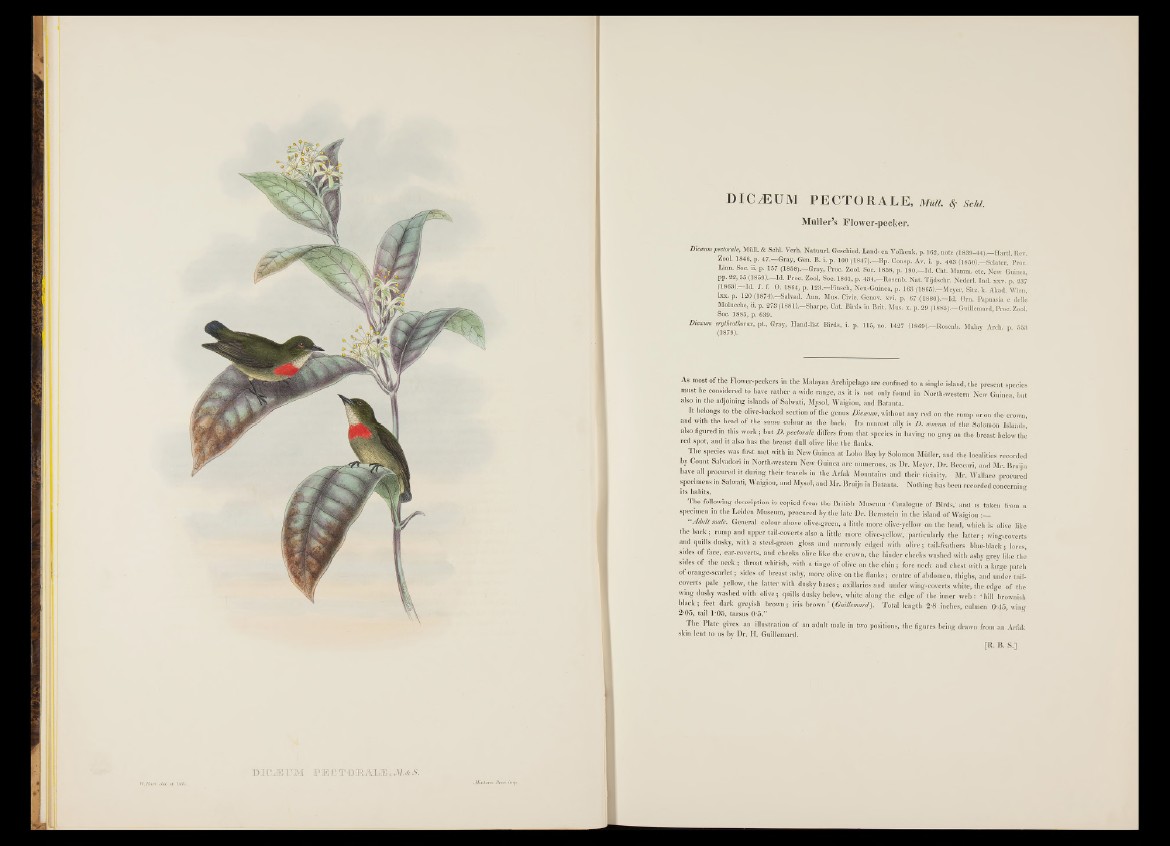
BICÆUM PE C T OiRAIÆ, M . A &
V.Hart ciel, e t UÜv. Minterm Br\w. imp.
DICÆUM PECTORALE, m m . % sm .
Müller’s Flower-pecker.
D km m pectorale, Hffll. & Sclil. Verh. Natural. GescMed. Land- en Volkenk. p. 162, note (1833- 14).—Haiti. Rev.
Zool. 1846, p. 47— Gray, Gen. B. i. p. 100 (1847)— Bp. Consp. A t. i. p. 403 (1850)— Sclater, Proc!
Lmn. Soc. ii. p. 157 (l;8:?l|—Gray, Proe. Zool. Soc. 1858, p. 190— Id. Cat. Mamm. etc. New Guinea,
pp. 22,66 (1859)— Id. Proc. Zool. Soc. 1861, p. 434— Roaenb. Nat. Tijdschr. Nederl. Ind. xxv. p. 237
(1863)— Id. J. f. O. 1864, p. 123—Finsch, Neu-Guinea, p. 163 (1865).—Meyer, Sitz. k. Akad. Wien,
lxx. p. 120 (1874)—Salvad. Ann. Mus. Civic. Genov, rvi. p. 67 (18.80).—Id, Orn. Papuasia e délié
Molucche, ii. p. 273 (1881).—Sharpe, Cat. Birds in Brit. Mus. x. p. 29 (1885).—Guillemard, Proc. Zool
Soc. 1885i p. 639.
Dicxum erythrothorax, pt., Gray, Hand-list Birds, i. p. 115, no. 1427 (1869)— Rosenb. Malay Arch n 553
(1879). ■
As most o f the Flower-peckers in the Malayan Archipelago are confined to a single island, the present species
must be considered to have rath er a wide range, as if is not Only-found in North-western New Guinea, hut
also in the adjoining islands of Salwati, Mysol, Waigion, and Batanta.
I t belongs to the Oliver-backed section o f the genus Dicoeum, without any red on the rump or on the crown,
and with the head o f the same colonr as the back. Its nearest ally is D. æneum o f the Solomon Islands!
also figured in this work ; but I). pectorale differs from that species in having no grey on the breast below thé
red spot, and it also has the breast dull olive like the flanks.
The species was first met with in New Guinea at Lobo Bay by Solomon Müller, and the localities recorded
by Count Salvador, in North-western New Guinea a re numerous, as Dr. Meyer, Dr. Beccari, and Mr. Brnijn
have all procured it during their travels in the Arfak Mountains and their vicinity. Mr. Wallace procured
specimens in Salwati, Waigion, and Mysol, and Mr. Bruijn in Batanta. Nothing has been recorded concerning
its habits.
The following description is copied from the British Museum « Catalogne of Birds,’ and is taken from a
specimen in the Leiden Museum, procared by the late D r. Bernstein in the island o f Waigiou :-§§li
Adult male. General colour above olive-green, a little more olive-yellow on the head, which is olive like
the back; rump and upper tail-coverts also a little more olive-yellow, particularly the la tte r; wing-coverts
and quills dnpky, with a steel-green gloss and narrowly edged w ith |§ jiv e ; tail-feathers blue-black; lores,
sides o f face, ear-coverts, and cheeks olive like the crown, the hinder cheeks washed with ashy grey like the
sides o f the neck ; throat whitish, with a tinge o f olive on the chin ; fore neck and chest with a large patch
of orange-scarlet ; sides o f breast ashy, more olive on the flanks ; centre o f abdomen, thighs, and under tail-
coverts pale yellow, the latter with dusky bases ; axillaries and under wing-coverts white, the edge o f the
wing dusky washed with olive ; quills dusky below, white along the edge o f the inner web : ‘ bill brownish
black ; feet dark greyish brown ; iris brown ’ ( Guillemard). Total length 2-8 inches, culmen 0-45, wing
2*05, tail l -05, tarsus 0 -5 .”
The Plate gives an illustration of an adult male in two positions, the figures being drawn from an Arfak
skin lent to us by Dr. H. Guillemard.
[R. B. S.]